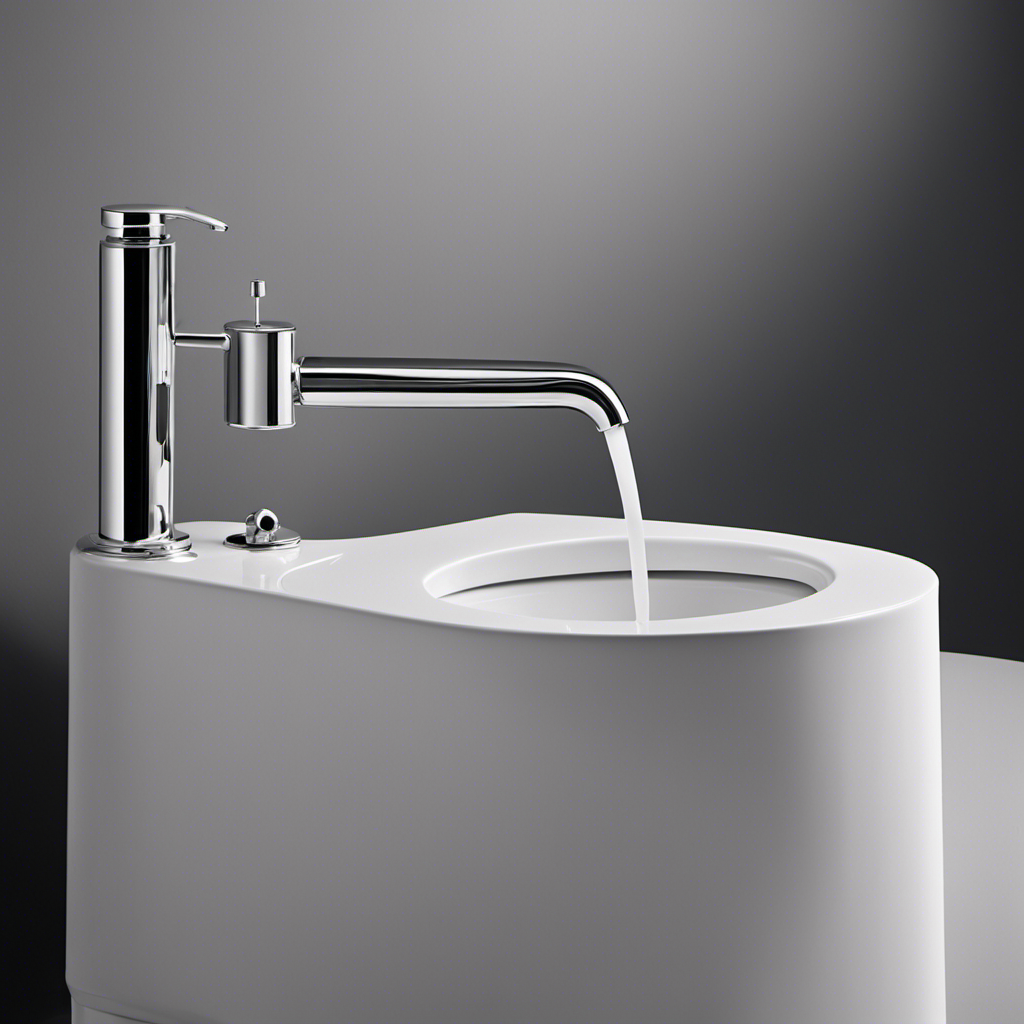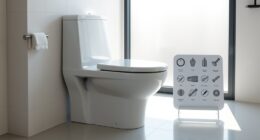As I dove into the world of accessible bathroom design, I found myself wondering just how tall a handicap toilet should be. Well, let me tell you, the answer is not as straightforward as I initially thought.
In this article, I will guide you through the average height of handicap toilets, the ADA guidelines that dictate their dimensions, and the various factors you should consider when choosing the right toilet height.
So, buckle up and get ready to dive deep into the world of accessible bathroom fixtures!
Key Takeaways
- Handicap toilet seats should be between 17 to 19 inches from the floor according to ADA guidelines.
- The height of the toilet seat can be adjusted using an elevated toilet seat or raised toilet seat attachment.
- Consider factors such as mobility limitations, height, body proportions, and existing medical conditions when choosing the right toilet height.
- Regular maintenance of the elevated seat attachment is important for ensuring good working condition and proper installation.
Average Height of Handicap Toilets
The average height of handicap toilets is typically higher than standard toilets. This is due to the importance of accessibility in public restrooms. Handicap toilets are designed to accommodate individuals with disabilities, making it easier for them to use the restroom independently.
One common misconception about handicap toilet heights is that they are excessively tall, which is not true. The Americans with Disabilities Act (ADA) guidelines specify that the height of the toilet seat should be between 17 to 19 inches from the floor. This range ensures that individuals with mobility issues can transfer from their wheelchair or mobility aid to the toilet seat comfortably.
It is crucial to understand the proper height of handicap toilets to provide equal access and promote inclusivity in public facilities.
ADA Guidelines for Toilet Height
According to ADA guidelines, the height of a toilet for individuals with disabilities is standardized. The ADA specifies that the toilet seat height should be between 17 and 19 inches from the floor. This standard height is based on extensive research and takes into consideration the needs of individuals with disabilities.
The impact of toilet height on accessibility and user comfort is significant. Higher toilet heights have several pros and cons. On the positive side, a higher toilet can make it easier for individuals with limited mobility to sit down and stand up. It reduces the strain on their knees and hips. Additionally, a higher toilet can provide better accessibility for wheelchair users, allowing them to transfer more easily.
However, there are also potential drawbacks to higher toilet heights. Some individuals may find it uncomfortable or difficult to use a taller toilet, especially if they have shorter legs or mobility issues. It’s important to consider individual preferences and needs when determining the appropriate toilet height.
Overall, the standardized height for toilets according to ADA guidelines ensures accessibility and user comfort for individuals with disabilities. However, it is essential to consider the pros and cons of higher toilet heights and take into account individual preferences and needs.
Variations in Handicap Toilet Heights
You should consider the different heights available for accessible toilets. Many people have misconceptions about handicap toilet heights, assuming that they are all the same. However, the height of a handicap toilet can vary depending on the needs of individuals with disabilities.
Here are some key points to understand the impact of toilet height on accessibility for individuals with disabilities:
-
Common misconceptions about handicap toilet heights: People often assume that all accessible toilets are the same height, but this is not the case. There are different options available to accommodate different needs.
-
The impact of toilet height on accessibility: The height of a toilet can greatly affect the accessibility for individuals with disabilities. A higher toilet can make it easier for people with mobility issues to transfer onto and off of the seat.
-
Adjustable heights: Some accessible toilets come with adjustable heights, allowing individuals to customize the toilet to their specific needs.
-
ADA guidelines: The Americans with Disabilities Act (ADA) provides guidelines for the height of accessible toilets, ensuring that they meet the needs of individuals with disabilities.
Understanding the variations in handicap toilet heights is crucial for creating an inclusive and accessible environment for all individuals.
Factors to Consider for Choosing the Right Toilet Height
When choosing the right height for a toilet, it’s important to consider various factors. One of the key factors is the accessibility requirements.
For individuals with mobility issues or disabilities, having a toilet seat at the correct height is crucial for their comfort and independence. The Americans with Disabilities Act (ADA) has set guidelines for the height of accessible toilets, stating that they should be between 17 and 19 inches from the floor to the top of the seat. This ensures that people can easily transfer onto and off the toilet without straining or discomfort.
It is important to note that the height of the toilet seat can be adjusted by using an elevated toilet seat or adding a raised toilet seat attachment.
Tips for Adjusting Handicap Toilet Heights
One of the tips for adjusting the height of an accessible toilet is to use an elevated seat attachment. This attachment can be easily installed on top of the existing toilet seat, providing additional height and making it more convenient for individuals with mobility issues.
To ensure proper toilet height for accessibility, it is important to consider the following:
- Measure the height of the individual using the toilet to determine the appropriate height adjustment.
- Avoid raising the toilet seat too high, as it may cause discomfort or instability.
- Make sure the toilet seat attachment is securely fastened to prevent any accidents or injuries.
- Regularly check and maintain the elevated seat attachment to ensure it remains in good working condition.
Common mistakes to avoid when adjusting handicap toilet heights include:
- Not considering the individual’s specific needs and preferences.
- Failing to properly install or secure the elevated seat attachment.
- Neglecting to regularly clean and maintain the attachment.
- Overlooking the importance of proper measurements and adjustments for optimal accessibility.
Conclusion
In conclusion, determining the height of a handicap toilet is crucial for ensuring accessibility and comfort for individuals with disabilities. By following ADA guidelines, which stipulate a minimum height of 17-19 inches, one can guarantee compliance and inclusivity.
However, it is important to consider variations in toilet heights, as some may opt for taller options for added convenience. Ultimately, selecting the right toilet height involves careful consideration of individual needs and preferences.
Remember, adjusting handicap toilet heights is like finding the perfect balance, ensuring everyone can reach new heights of comfort and convenience.










